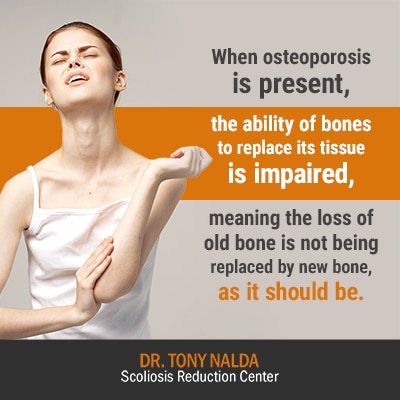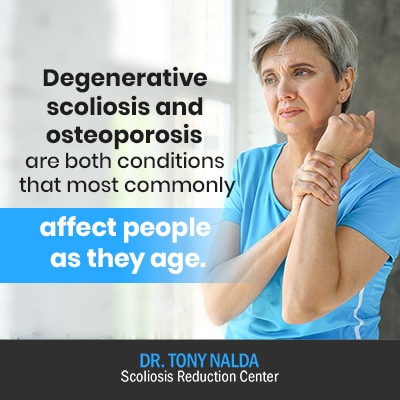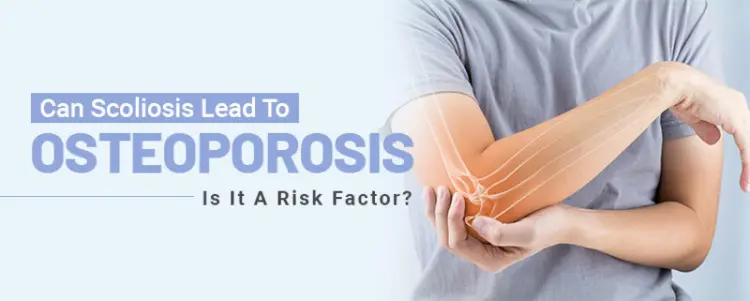The connection between scoliosis and osteoporosis is still being explored. While there are studies showing a link between low bone mass and scoliosis, it’s yet to be clearly proven that scoliosis is the cause. There is also the possibility that low bone mass contributes to the onset of scoliosis.
The etiology of idiopathic scoliosis has been explored in relation to bone health, and osteoporosis makes bones weak and prone to fractures. While links have been found between adolescent idiopathic scoliosis and low bone mass, a clear causative link between osteoporosis and degenerative scoliosis remains unclear.
While osteoporosis generally affects older people, there have been some interesting findings in terms of the connection between low bone mass and adolescent idiopathic scoliosis (AIS), the condition’s most common form. Before we move on to exploring the connection between scoliosis and osteoporosis that develops later in life, let’s take a look at some of the defining features of both conditions: scoliosis and osteoporosis.
How Scoliosis Affects the Spine
When scoliosis develops, this means there is an abnormal sideways curvature to the spine that includes rotation.
The spine has three main healthy and natural curves that characterize the spine’s three main sections: cervical (neck), thoracic (middle and upper), and lumbar (lower). These curves give the spine more strength, flexibility, and the ability to evenly distribute the mechanical stress that’s incurred during movement.
When one of these natural and healthy curvatures are lost, the body responds by putting in counteracting curves in the opposite direction, in an attempt to help stabilize and support the misaligned spine.
When this happens, the spine’s overall biomechanics are disrupted, and depending on condition severity and form, it can affect multiple areas of the body by causing postural changes and producing a wide range of symptoms.
One of the defining features of scoliosis, and the big challenge behind treating it, is its progressive nature.
Scoliosis Progression
Scoliosis is a progressive condition, meaning that it’s in its very nature to get worse over time. This would be evident by the curvature increasing in size, likely producing more noticeable symptoms such as postural changes and pain (in adults).
The main challenge behind addressing progression in scoliosis treatment is that there is no full-proof way to determine how fast, or slow, a person’s condition is going to progress. What we do know, however, is that every case will progress at some point, if left untreated.
One of the ways we determine the severity level of a patient’s condition is through a scoliosis X-ray and a measurement known as the ‘Cobb angle’. The Cobb angle is commonly referred to as the ‘orthopedic gold standard for scoliosis assessment’.
Cobb angle is measured by drawing intersecting lines from the bottom and top of the curvature’s most-tilted vertebrae (bones of the spine). A patient’s Cobb angle tells us just how far out of alignment their spine is and classifies their condition as mild, moderate, severe, or very severe:
- Mild scoliosis: Cobb angle measurement of between 10 and 25 degrees
- Moderate scoliosis: Cobb angle measurement of between 25 and 40 degrees
- Severe scoliosis: Cobb angle measurement of 40+ degrees
- Very-severe scoliosis: Cobb angle measurement of 80+ degrees
You can tell by the range of numbers that the severity of scoliosis really varies; in fact, the largest curvature I have seen was 150 degrees, so from 10 degrees into the hundreds, you can imagine how much the symptoms and other related issues would vary.
I should also mention that in addition to rotation, for a scoliosis diagnosis to be given, a patient has to have a minimum Cobb angle measurement of 10 degrees.
Now that we have discussed what’s happening to the spine when scoliosis develops, plus its progressive nature and severity levels, let’s touch on the different types of scoliosis that a person can develop at different stages of life.
Different Types of Scoliosis
Scoliosis is often described as a complex and mysterious condition. This is mainly because of the mystery surrounding the etiology of its most common form: adolescent idiopathic scoliosis (AIS).
AIS is diagnosed between the ages of 10 and 18 and accounts for 80 percent of known diagnosed scoliosis cases. The ‘idiopathic’ designation means there is no single-known cause. The remaining 20 percent consist of types with known causes: neuromuscular, congenital, degenerative, and traumatic.
Neuromuscular: scoliosis that develops because there is a larger neuromuscular condition, such as cerebral palsy or muscular dystrophy, present.
Congenital: scoliosis that develops in utero due to a bone malformation in the spine.
Degenerative: scoliosis that develops due to degenerative changes to the spine due to aging and/or the cumulation of certain lifestyle choices. This form of scoliosis most commonly affects older people as the spine faces the degenerative effects of aging.
Traumatic: scoliosis that develops because the spine has experienced significant trauma, such as in a car accident or fall.
While we can’t attribute AIS onset to one single cause, experts generally agree that it is, instead, multifactorial, meaning its onset can be attributed to multiple factors that can vary from one person to the next.
Scoliosis Progression
Progression is an important feature of AIS. As I mentioned, we can’t fully predict a person’s rate of progression, but we do know certain factors that contribute to it, the main one being growth.
Adolescents entering into puberty are at a high risk of progression because this stage of development is marked by rapid and unpredictable growth spurts. If we can diagnose scoliosis early on in the condition’s progessive line, we have better chances of impacting it on a positive level and designing a treatment plan to stay ahead of a patient’s progressive line.
While progression tends to slow once skeletal maturity has been reached, it is still a factor in adult scoliosis, especially in degenerative scoliosis where the condition develops because the spine is facing degenerative changes.
This is why, here at the Scoliosis Reduction Center®, we believe in the benefits of early detection and proactive treatment. We do everything in our power to help our patients to never reach the higher stages of progression because this means avoiding the hardships and increasing symptoms that tend to accompany the increasing severity levels.
So we know that scoliosis has different forms that can affect different age groups, and we know that it’s a progressive condition that will get worse if left untreated. We also know that growth is the big trigger for progression and that as a spinal condition, scoliosis affects the alignment of the bones of the spine.
Now, let’s take a look at another prevalent condition that impacts the health and function of bones: osteoporosis.
Osteoporosis
Osteoporosis is a condition that makes the bones weak and susceptible to fractures. It can make the bones so brittle that a fall, movement, or cough can lead to a fracture. Osteoporosis-related fractures commonly affect the hip, wrists, or spine.

Bone is a form of living tissue that is constantly broken down and replenished. When osteoporosis is present, the ability of bones to replace its tissue is impaired, meaning the loss of old bone is not being replaced by new bone, as it should be.
While osteoporosis affects both men and women, it’s most common in peri- and post-menopausal women due to the hormonal changes that alter bone density.
Osteoporosis Symptoms
The early stage of osteoporosis isn’t known to commonly produce noticeable symptoms as it can happen gradually. Once osteoporosis has weakened bones to a certain level, common signs and symptoms can include:
- Back pain due to a collapsed vertebra or fracture
- Stooped posture
- Gradual loss of height
- Bones that are brittle and fracture easily
Osteoporosis Causes
Healthy bones are able to renew and replenish themselves by breaking down old bone and replacing it with new bone.
In youth, the body makes new bone quicker than old bone breaks down, which increases bone mass. As we move into the late 20s, the process starts to slow, and the majority of people reach their peak bone-mass level by 30. As we age, bone mass is lost faster than it’s made.
While the chances of developing osteoporosis increase with age, that doesn’t mean that every older person will automatically develop it. The likelihood of developing the condition will depend on a number of factors, including how much bone mass was reached in youth. The higher a person’s peak bone mass was, the more bone reserve they have for later in life and the less likely a person is to develop osteoporosis as they age.
Peak bone mass can also be affected by genes and varies amongst different ethic groups as well.
Osteoporosis Risk Factors
Let’s look at some additional risk factors that increase chances of osteoporosis development related to age, race, lifestyle, medical conditions and treatment:
- Gender – women are more likely to develop osteoporosis than men, due to changing hormone levels during menopause that affect bone density
- Age – bone mass decreases with age
- Race – people of caucasian or Asian descent are at the highest risk
- Genes – if a parent or sibling has osteoporosis, chances are higher that someone else in the family will develop it.
- Body frame – people with smaller body frames tend to have lower peak bone-mass levels to draw from
The above risk factors include variables that a person can’t control and are unchangeable; the following risk factors can fluctuate and/or be adjusted, such as hormone levels.
Hormone Levels
Hormones can impact bone health and strength, so people with too much or too little of certain hormones carry higher risk factors for developing osteoporosis.
Lower sex hormones can weaken bone. Lower estrogen levels in women going through menopause is a particularly high osteoporosis risk factor.
Thyroid issues such as high levels of thyroid hormone can lead to bone loss. This can happen with overactive thyroids, or if a person takes high levels of thyroid medication for treating an underactive thyroid.
Osteoporosis has also been known to affect other glands that can impact hormone levels.
Diet
Low-calcium intake is the largest dietary risk factor as low levels of calcium throughout life can lead to lesser bone density and early bone loss.
Eating disorders generally lead to an unhealthy weight and weaker bones.
Gastrointestinal surgery has also been known to impact a person’s ability to absorb nutrients such as calcium, potentially leading to lower bone mass.
Medications
Medications such as steroids that are used for long periods of time can impair the ability of bones to produce new bone.
In addition, medications known to regulate or prevent seizures, cancer, gastric reflux, and transplant rejection are also known to impact bone health.
Certain Medical Conditions
People with medical conditions such as celiac disease, kidney disease, liver disease, inflammatory bowel disease, lupus, and rheumatoid arthritis are at higher risk of developing osteoporosis.
These types of conditions can affect hormone production, digestion, and nutrient absorption.
Certain Lifestyle Choices
Certain bad lifestyle habits can increase a person’s risk of developing osteoporosis including leading a sedentary lifestyle, excessive consumption of alcohol, and tobacco use; these habits impact a person’s overall health and are known to potentially weaken bones over time.
How Osteoporosis can Affect the Spine
As mentioned earlier, the main complication of osteoporosis involves susceptibility to fractures due to weak and brittle bones.
When the vertebrae of the spine are weakened to the point that they crumple, a spinal fracture can easily occur, even without an accident like a fall. When the spinal bones are significantly weakened and brittle, they can degenerate quickly, causing back pain, a loss of height, and a hunched-forward posture.
Osteoporosis-related bone fractures, especially those that involve the hip and spine, can be very serious. Most commonly, hip fractures are the result of a fall, and they can result in significant disability.
There is also a strong link between osteoporosis-related hip fractures caused by a fall and an increased risk of death in the year preceding the fall.
Now that we have looked at some of the defining features of osteoporosis, let’s talk about the potential connection between scoliosis and osteoporosis, and if one can contribute to the onset of the other.
Scoliosis and Osteoporosis
Considering how osteoporosis most commonly affects people as they age, degenerative scoliosis, also common amongst older people, seems to share the largest potential causative connection with osteoporosis; however, before we move on to discuss that connection, let’s take a look at the role of bone mass in the etiology of the condition’s most common form: adolescent idiopathic scoliosis (AIS).
Adolescent Idiopathic Scoliosis, Osteopenia, and Osteoporosis
As AIS accounts for 80 percent of known diagnosed scoliosis cases, the condition’s etiology has been explored in multiple ways, including in relation to bone health and formation.
One such study examined the connection between scoliosis and osteopenia and osteoporosis amongst adolescent girls. Osteopenia is when bones are weaker than they should be, but they are not quite brittle enough to break easily (defining feature of osteoporosis).
The goal of the study was to assess the prevalence of low bone mass amongst girls with AIS and their siblings. Subjects had their weight and height measured to determine their body mass index (BMI) and had DEXA scans of the hip and spine to determine their bone mineral density (BMD).
The siblings without scoliosis were the control subjects, and their BMI and BMD were calculated and compared to those of their siblings with scoliosis. The prevalence of low bone mass in the girls with scoliosis indicates that scoliosis could cause osteopenia and osteoporosis, as the siblings with normal spines showed normal bone mass.
While research does indicate a high prevalence of low bone mass in girls with AIS, it has yet to be clearly proven that scoliosis is the direct cause. In addition, the reverse could also be said: that low bone mass could be one of the contributing factors to the onset of AIS, especially as the condition is regarded as multifactorial, meaning caused by a combination of variables.
In conclusion, the study suggests that scoliosis does contribute to low bone mass in scoliotic spines, as the siblings without scoliosis, who obviously share the same lifestyle and genes, showed normal levels of bone mineral density. The study also stated that the severity of osteopenia and osteoporosis was dependent upon the subject’s degree of Cobb angle.
Degenerative Scoliosis and Osteoporosis

Degenerative scoliosis and osteoporosis are both conditions that most commonly affect people as they age.
Degenerative scoliosis develops when the spine has faced degenerative changes that predispose the spine to losing its natural and healthy curvatures. It’s the spine’s intervertebral discs that commonly face degenerative changes and lead to the development of degenerative scoliosis.
The intervertebral discs sit between adjacent vertebrae so they don’t rub against each other and experience friction during movement; the discs also facilitate the spine’s flexibility, its ability to evenly distribute mechanical stress, and help to sustain the spine’s healthy and natural curvatures.
Degenerative changes facing the spine can also be the result of certain lifestyle choices that have a cumulative effect on the spine’s overall health; these would include not maintaining a healthy weight or activity level, not staying hydrated enough to help replenish the intervertebral discs, practicing poor posture, and repeatedly lifting objects incorrectly so the spine is strained.
The presence of other conditions affecting the spine such as osteoarthritis and osteoporosis are also known to impact the spine’s overall health and function and can increase spinal degeneration, leading to the development of degenerative scoliosis.
So can scoliosis lead to osteoporosis in adults? Unfortunately, I can’t give a simple ‘yes’ or ‘no’ answer because there has yet to be a clear direct causative link found between scoliosis and osteoporosis. What might be more accurate to say is that osteoporosis, and conditions like it that can affect the health of the spine’s vertebrae, is a risk factor for scoliosis.
Osteoporosis, as it has the potential to weaken bones to the point of causing fractures, also has the potential to weaken vertebrae to the point that they crumple and the spine is no longer stable enough to maintain its healthy position and alignment.
Conditions with the potential to adversely affect the spine’s overall health and function, by extension, also have the potential to impact the spine’s ability to maintain its healthy curvatures, leading to the spine ‘sagging’, so to speak, becoming misaligned, and developing scoliosis.
Conclusion
While the prevalence of low bone mass in adolescents with scoliosis does suggest a potential link between osteoporosis and scoliosis, whether that connection is direct or indirect has not been clearly determined.
When it comes to the development of degenerative scoliosis in adults, osteoporosis is considered a risk factor as the condition has the potential to adversely affect the overall health and function of the spine by weakening its bones, making them prone to injury and misalignment.
While scoliosis negatively impacts the spine’s structure in terms of its overall rotation and alignment, it’s not known to weaken the structure of its individual bones (vertebrae) to the extent that osteoporosis can, which is why osteoporosis is more commonly considered a risk factor for scoliosis, than the other way around.





